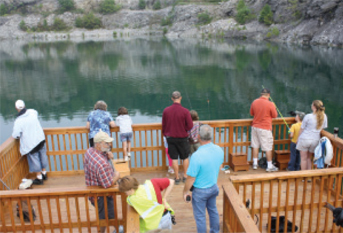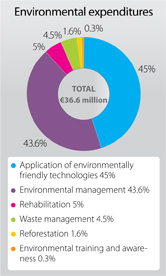
< U.S.A.
Trout pond in an old limestone pit (Roanoke cement plant, Virginia, U.S.A.)
TITAN America’s Roanoke Cement is continuing work on the Trout Pond Restoration Project, initiated in 2008 and designed to create a sustainable ecosystem rich in biodiversity.
The site was previously a working limestone quarry, but has long been abandoned. Filled by groundwater inflows and rainfall, a 24,000 m2 (six acre) portion of the pit has been developed into a lake. In 2009 a partnership was forged with Trout Unlimited, a national organization dedicated to conserving, protecting and restoring North America’s trout and salmon fisheries and their watersheds. In 2009, 350 rainbow trout were released into the quarry pond, and the site is now considered ideal for hosting this environmentally sensitive species. To take full advantage of the shoreline, a 3x6 meter (10’x20’) fishing pier with floating dock was constructed out of pine, allowing visitors to fish or view wildlife; annual “fishing days” at the pond are organized for Roanoke Cement employees and their families. The quality of water inside the pond is monitored annually through measurements of water temperature, in order to assess conditions for trout survival.
Adjacent to the pond, the site also offered 780 m2 (8,400 square feet) of land for restoration.
The restoration project began by leveling out the rock and placing on-site clay soil - taken from overburden in the operating quarry site - for planting over the area. On the far left of the pond, a shallow area was created to grow wetland vegetation.
Plantings included eight Tuscarora Crape Myrtles, two Weeping Willows, four Spiraling Willows and Cattails. Kentucky 31 Tall Fescue grass seed was sown - perfect for the clay soil conditions surrounding the trout pond. The fescue has a widespread root system allowing the grass to be highly drought resistant. Plant species found in the region or native to the state were favored as sustainable choices, based on the results of a biodiversity study, conducted in collaboration with Roanoke College. To bring in more native wildflowers, two clay beds were laid out along the bank of the pond.
Native habitats were created adjacent to the trout pond using premixed seed including Indiangrass, Canada Wild Rye, Big Bluestem, Partridge Pea, Ox Eye Sunflower, Black Eyed Susan and Switchgrass.
Bird feeders and birdhouses were installed to lure native species back to the area. The various birdhouses included eco-friendly structures hung near the trout pond as well as globe cage feeders that resist squirrels and species of birds that intimidate smaller birds.
A variety of species now reside at the trout pond in multiple habitats. Restored fauna include several different species of dragonflies that require water for breeding. These species are especially important indicators for gauging the health of a trout pond.
The restored trout pond is a sanctuary for dragonflies, and other species like butterflies and grasshoppers. The trout pond is an oasis for native birds providing them with fresh water, food and nesting materials.
In July 2011, the Roanoke Cement Company was recognized by Virginia DMME (Division of Mining Mineral and Energy) and VTCA (Virginia Transportation Construction Alliance) with the “Best Quarry” Reclamation Award.


